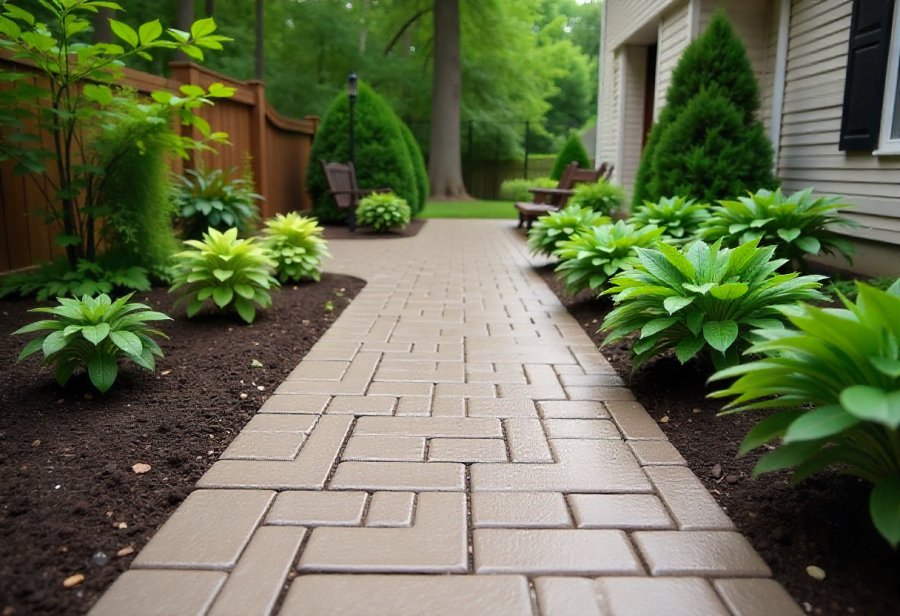Imagine transforming urban landscapes into resilient, eco-friendly spaces capable of combating floods with a simple yet powerful solution: permeable pavers. These innovative surfaces allow rainwater to seep naturally into the ground, reducing runoff and alleviating pressure on overwhelmed stormwater systems. But how do these porous surfaces not only prevent street flooding during intense storms but also improve water quality and support groundwater recharge? The answer lies in their sophisticated design, evolving from basic porous materials to advanced, smart, and sustainable solutions that adapt to changing climates. As cities worldwide adopt permeable paving in parking lots, sidewalks, and plazas, they are not just managing water—they’re creating greener, more livable communities. With technological advances like embedded sensors and new materials promising even greater resilience, could permeable pavers be the key to future-proofing our urban environments against increasing weather extremes?

Revolutionizing Urban Flood Prevention with Permeable Pavers
Permeable pavers are transforming how cities manage heavy rainfall and flooding. Unlike traditional surfaces such as concrete or asphalt, these specially designed materials allow rainwater to pass through and soak into the ground beneath. This natural infiltration process reduces the volume of water rushing over surfaces, helping to prevent street flooding and water pooling during storms. By managing water at its source, permeable pavers ease the burden on existing drainage systems, which often struggle to keep up during intense weather events.
The significance of permeable paving extends beyond flood control. These surfaces support groundwater recharge by allowing water to filter into underground aquifers, which are vital sources for drinking water, agriculture, and natural ecosystems. They also help remove pollutants like sediments, oils, and chemicals from stormwater, leading to cleaner water reaching rivers and lakes. This dual benefit of flood mitigation and water purification makes permeable pavers a key component of sustainable urban water management.
As urban areas expand and climate patterns become more unpredictable, the need for effective stormwater solutions grows. Permeable pavers offer a practical and aesthetically pleasing way to address these challenges. They can be installed in parking lots, sidewalks, plazas, and other public spaces, turning functional surfaces into eco-friendly zones. These surfaces not only prevent flooding but also contribute to greener, more resilient communities that are better prepared for future storms.
Proper installation is critical to ensuring permeable pavers perform as intended. This involves selecting the right materials—such as permeable concrete, porous asphalt, or interlocking pavers—and preparing the base with gravel and geotextile fabrics to maximize water flow. Maintenance, including regular cleaning to prevent clogging, is essential to keep systems functioning effectively over the long term. When installed and maintained correctly, permeable paving becomes a reliable tool for urban flood prevention.
The growing adoption of permeable pavers highlights their role as a practical, sustainable solution. Cities around the world are seeing positive results, with reduced runoff and less street flooding during storms. These surfaces help maintain traffic flow, protect property, and preserve environmental quality. By integrating permeable paving into urban planning, communities can create safer, more adaptable spaces that turn a flood risk into an opportunity for greener, healthier neighborhoods.
From Gravel to Smart Materials: The Evolution of Permeable Paving
The development of permeable paving has its roots in the search for sustainable urban water management solutions. Early efforts focused on simple porous surfaces like gravel and permeable bricks, primarily used to reduce runoff and encourage groundwater recharge in areas with limited rainfall. These basic systems served communities well in reducing surface water flow, especially in parking lots and walkways, but their performance was often limited by materials and design constraints.
As understanding of urban hydrology advanced, engineers began to experiment with more sophisticated materials and construction techniques. The introduction of permeable concrete, porous asphalt, and interlocking pavers with interconnected voids marked a significant leap forward. These innovations were driven by scientific research into water flow, pore size, and filtration, allowing for systems that combined durability with high permeability. Such developments made permeable paving suitable for high-traffic areas, broadening its practical application.
Research into the science behind water movement through porous materials played a crucial role in refining these systems. By studying pore structures and flow rates, engineers optimized materials to maximize infiltration while maintaining structural integrity. This scientific insight led to the creation of new materials that resist clogging and degradation, ensuring long-term functionality even under heavy use and adverse weather conditions.
Design strategies evolved to emphasize proper installation practices—such as ensuring correct slope, adequate base preparation, and the use of geotextile fabrics—to support water infiltration and prevent clogging. These technical improvements increased the systems’ longevity and performance, making permeable paving a reliable part of urban infrastructure. Proper maintenance, including regular cleaning and inspection, further extends their effectiveness over time.
Modern advancements have also incorporated innovative installation techniques like modular designs and smart monitoring systems. Sensors embedded within permeable surfaces now provide real-time data on permeability levels, enabling proactive maintenance and early detection of clogging. This technological integration enhances system resilience and ensures consistent flood mitigation performance.
The evolution of permeable paving reflects a broader shift towards holistic, sustainable urban water management. Early porous surfaces served limited roles, but today’s systems are multifunctional—combining flood control, water quality improvement, and ecological benefits. When integrated with green infrastructure elements like rain gardens and bioswales, permeable paving mimics natural water cycles, supporting urban resilience and biodiversity.
Looking ahead, ongoing research aims to develop smarter, more durable materials that adapt to changing climate conditions. Innovations such as self-cleaning surfaces and energy-efficient systems are on the horizon, promising even greater reliability and environmental benefits. These advancements will continue to shape permeable paving as a central component of resilient, eco-friendly cities.

How Permeable Pavers Naturally Reduce Flooding and Support Environmental Health
Permeable pavers offer a straightforward yet powerful way to naturally reduce runoff and mitigate urban flooding. When rain hits these porous surfaces, water seeps directly into the ground instead of rushing over the surface and overwhelming stormwater systems. This process keeps streets and sidewalks clearer during heavy storms, helping to prevent water pooling and street flooding before it begins.
By allowing water to infiltrate into the soil, permeable paving eases the load on overwhelmed drainage infrastructure. Instead of channeling all rainfall into storm drains that can clog or overflow, these surfaces manage water right at its source. This localized absorption reduces flood risks, protects property, and keeps traffic flowing smoothly during extreme weather events fueled by climate change.
Beyond flood control, permeable pavers significantly improve urban water quality. As rainwater passes through the porous layers, pollutants like sediments, oils, and chemicals are naturally filtered out. This process results in cleaner water reaching groundwater sources and waterways, supporting healthier ecosystems and reducing pollution downstream.
Groundwater recharge is another vital benefit. When rainwater percolates through permeable surfaces, it replenishes underground aquifers that serve as essential water sources for communities, agriculture, and natural habitats. This recharge process helps sustain local water cycles, especially in drought-prone areas, and decreases dependency on imported or treated water supplies.
Reducing runoff also benefits the environment by lessening the strain on natural drainage channels and wetlands. Instead of artificially directing stormwater, permeable paving restores a more natural water flow, supporting biodiversity and ecological resilience. This approach aligns urban development with natural water processes, making cities more adaptable to heavy rains and climate variability.
Incorporating permeable pavers into urban spaces transforms functional areas into eco-friendly zones. Their aesthetic flexibility allows cities to blend practicality with visual appeal, creating inviting, resilient communities. These surfaces do more than prevent floods—they foster healthier, greener environments that are better prepared for the increasing challenges of climate change.
To explore more about how permeable pavers contribute to sustainable urban development, consider visiting this resource on permeable pavers and their environmental benefits. Incorporating these systems not only helps reduce flooding but also supports long-term ecological health and resilience in our communities.
Transforming Cities: Practical Applications of Permeable Pavers in Flood Management
Permeable paving is increasingly being adopted in urban environments as a practical, effective solution for stormwater management and flood prevention. Cities are installing permeable pavers in parking lots, allowing rainwater to pass through the surface and be absorbed into the ground below. This approach significantly reduces runoff during heavy rains, which often causes water pooling and street flooding. By letting water seep naturally into the soil, these surfaces help ease the load on stormwater systems that can become overwhelmed during storms.
Sidewalks and walkways also benefit from permeable surfaces. Instead of traditional concrete or asphalt that quickly sheds water, permeable paving keeps pedestrian areas dry and safe even during intense rainfall. Public plazas, driveways, and green spaces are being transformed with these installations, blending functionality with natural water management. This not only improves drainage but also enhances the aesthetic appeal of urban areas, creating inviting, environmentally friendly spaces.
Proper planning and installation are key to maximizing the benefits of permeable paving projects. Selecting suitable materials—such as permeable concrete, porous asphalt, or interlocking pavers—is just the first step. Ensuring correct slope, adequate base preparation, and the use of geotextile fabrics support water infiltration and prevent clogging. Attention to detail during installation, like avoiding compacting the void spaces, helps maintain permeability and prolongs system lifespan.
Maintenance plays a vital role in keeping permeable systems effective over time. Regular cleaning to remove debris, leaves, and sediments prevents pores from clogging and ensures water can flow freely. Inspections after storms help identify areas where water may pool or clog, allowing for prompt intervention. Consistent upkeep is essential to sustain flood mitigation benefits and extend the system’s durability.
Cities worldwide are witnessing positive results from these efforts. Portland’s retrofit parking lots with permeable pavers have greatly decreased runoff and street flooding during storms. Melbourne’s permeable sidewalks have channeled stormwater into the ground, reducing water levels and property damage. These examples demonstrate how thoughtful implementation and ongoing maintenance turn permeable paving into a reliable, scalable urban flood management tool.
Ultimately, integrating permeable pavers into city planning offers a practical way to adapt to increasing rainfall and urban growth. When installed properly and maintained diligently, these surfaces serve as resilient, eco-friendly infrastructure that protects communities from flooding while enhancing neighborhood aesthetics. This approach not only addresses immediate stormwater challenges but also supports long-term urban sustainability and climate resilience.
Transform Your Outdoor Space into a Stunning Oasis with Toronto Landscape & Design
Discover the unparalleled expertise of Toronto Landscape & Design in creating a beautiful retreat right in the heart of Toronto. Our award-winning designers meticulously consider every detail to craft personalized outdoor spaces that include natural stone features, serene water gardens, efficient irrigation systems, and durable retaining walls. Whether you’re envisioning a peaceful backyard sanctuary or a striking landscape upgrade, Toronto Landscpe is committed to bringing your vision to life. Contact us at https://TorontoLandscapeDesign.com or call 1.416.644.0499 to start transforming your outdoor environment into a breathtaking haven you can enjoy for years to come.

Paving the Future: Innovations and Trends in Permeable Stormwater Solutions
Emerging trends in permeable paving point toward a future where smarter, more adaptable infrastructure becomes central to flood prevention. Advances in material science are leading to the development of surfaces that can respond dynamically to changing weather conditions. For example, researchers are exploring smart materials capable of adjusting their permeability based on rainfall intensity, allowing surfaces to become more permeable during storms and less so during dry spells. This responsiveness helps prevent clogging and ensures maximum water infiltration precisely when it’s needed most.
At the same time, the integration of permeable paving with green infrastructure is gaining momentum. Combining these surfaces with rain gardens, bioswales, and vegetated corridors creates a comprehensive water management network that mimics natural water cycles. These systems not only enhance flood mitigation but also support urban biodiversity, reduce heat islands, and improve air quality, making cities more resilient and livable.
Sensor technology is transforming how cities monitor and maintain permeable systems. Embedded sensors can track permeability levels, clogging, and water flow in real time, providing actionable data for proactive maintenance. This real-time insight allows urban managers to address issues before flooding occurs, extending the lifespan of permeable surfaces and ensuring consistent performance. As sensors become more affordable and widespread, cities will increasingly rely on data-driven solutions to optimize stormwater management.
Looking ahead, permeable paving is poised to become a standard feature in resilient urban planning. Future designs will focus on surfaces that not only manage stormwater effectively but also contribute to broader ecological and climate goals. We may see multifunctional surfaces that incorporate energy generation or cooling features, transforming urban spaces into hubs of sustainability. This evolution aligns permeable paving with smart city initiatives, emphasizing environmental responsibility and community well-being.
Investing in pilot projects and fostering cross-disciplinary collaboration will be key to unlocking this future. Policymakers and urban planners should support innovative solutions and raise public awareness about the benefits of permeable paving. Educated communities are more likely to embrace these eco-friendly systems, accelerating adoption and inspiring further innovation. Public engagement combined with technological progress will drive the shift toward more resilient, adaptive cities.
Continued research into durable, self-cleaning materials promises to further enhance system longevity. Scientists are experimenting with composites that resist clogging and withstand harsh weather, reducing maintenance costs and operational disruptions. Future systems might harness rainwater for urban uses or incorporate energy-efficient features, making permeable paving a cornerstone of eco-friendly city design. These innovations will ensure that urban areas remain resilient against the increasing frequency of extreme weather events, securing water management and environmental health for generations to come.









